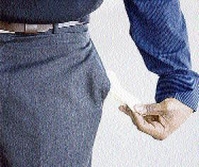
A worker with empty pockets. The Jamaica Productivity Centre says Jamaican workers have got poorer in 36 years.
Labour productivity or output per worker in Jamaica has been declining at an average annual rate of 1.5 per cent, according to data reviewed within a 36-year span, with the situation worsening within this decade.
But in the last five years incorporated in that study, 2003 to 2007, the rate doubled to 3.4 per cent per annum, said Dr Peter-John Gordon, director of the Jamaica Productivity Centre.
The findings of the new Jamaica Productivity Summary Report, which tracks data to 2007, also indicated that the worst trend in labour productivity has been observed in construction and installation, which declined, on average, by 3.4 per cent annually.
In these areas, growth in labour productivity engage relatively high capital/labour ratios.
In general, Jamaica compares poorly to most Caribbean countries which have experienced average per worker output growth of 1.5 per cent annually since 1972 and more than 2.0 per cent over the last 10 years.
'Becoming poorer'
According to Gordon, falling labour productivity implies that workers in Jamaica "are becoming poorer in a real sense", and Jamaica is becoming less competitive relative to the output of other countries.
"This means that the opportunity for expanding output from Jamaica - not only for exports but also to be able to compete on the local market - is being retarded. This restricts the ability of the economy to absorb additional workers and to pay them a decent wage," the researcher stated.
"Without an increase in productivity, the category of the working poor is likely to expand, if not the category of the unemployed."
Gordon, who is also a research fellow attached to the Sir Arthur Lewis Institute for Social and Economic Studies (SALISES) at the University of the West Indies, stated that in 10 years, 1998-2007, only mining and quarrying, manufacturing and electricity, gas and water recorded positive growth in labour productivity.
Largest annual decline
"The largest average annual decline in labour productivity (5.8 per cent) occurred between 1973 and 1977," said Gordon.
"During this period, output was declining at an average rate of 3.5 per cent per annum, while employment was growing at 2.4 per cent annually."
The second-worst period for labour productivity was between 2003 and 2007, when both employment and output were increasing.
But employment then grew at 5.2 per cent, outstripping output, which increased at 1.7 per cent annually.
According to the researcher, the best period for labour productivity was between 1988 and 1992, when growth was at 2.1 per cent per year.
Output in this period also grew at 3.5 per cent while employment grew at 1.4 per cent.
Other growth period
"The only other period in which labour productivity grew - at 0.5 per cent annually - was between 1998 and 2002," Gordon said.
The researcher concludes that increasing the output per worker continuously over time was the only way to have a sustainable increase in the standard of living of the population, noting that real gross domestic product (GDP) for the period 1973-2007 grew by 0.5 per cent per annually and that, because the population grew by a faster rate than GDP, real GDP per capita in 2007 was only 90 per cent of the level attained in 1972.
Measure of the wealth
Gordon said the Jamaica Productivity Centre, of which he is a director, was interested in GDP growth not as an end in itself but as a measure of the wealth created by people in the country.
"Ultimately we are interested in the welfare of the people. While welfare is a broad concept which encompasses many different things which affect the quality of life, GDP is meant to measure the material well-being of the population, that is, just how much wealth the people have access to," he said.
"We must concern ourselves not only with GDP levels and GDP growth, but with GDP per capita. To have a GDP per capita in 2007 below the level attained in 1972 means that, on average, each Jamaican is poorer in strictly material terms than was the case in 1972."
avia.collinder@gleanerjm.com